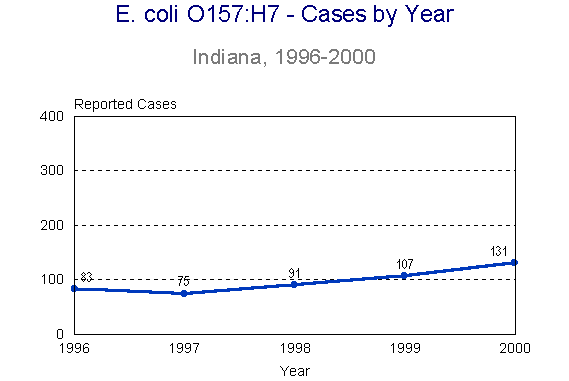Figure EC1: E. coli O157:H7 Cases by Year, Indiana, 1996-2000

2000 Indiana Report of Infectious Diseases |
View ISDH's Quick Facts on E. coli O157:H7
View CDC's E. coli O157:H7 page
Rates presented are per 100,000 population and are based on the U.S. 2000 Census.
| Cases | Incidence Rate |
|
| Total | 131 | 2.2 |
| Race-specific cases and rates1 | ||
| White | 90 | 1.7 |
| Black | 2 | *0.4 |
| Other2 | 3 | *1.2 |
| Sex-specific cases and rates3 | ||
| Female | 69 | 2.2 |
| Male | 60 | 2.0 |
Escherichia coli O157:H7 infection is a bacterial disease usually transmitted through raw or undercooked foods of animal origin or foods cross-contaminated by animal products or feces. It has most commonly been associated with raw or undercooked hamburger. Outbreaks have also been attributed to unwashed produce, unpasteurized juices, and swimming in or drinking untreated surface water. E. coli O157:H7 can also be transmitted person-to-person and is a special concern in the day-care setting. Rarely, patients can develop hemolytic uremic syndrome (HUS), marked by kidney dysfunction, hemolytic anemia, and platelet loss as a result of E. coli O157:H7. From 2 to 5% of E. coli O157:H7 cases will develop HUS, with most of those age 5 and younger.
There were 131 cases of E. coli O157:H7 reported in Indiana in 2000, which marks a 22% increase from the previous year (Figure EC1). Incidence of disease was greatest during the summer and early fall months, as seen in Figure EC2.
Case rates for males were slightly higher than those for females. Age-specific rates were greatest among preschool children (4.9) and infants (5.9) (Figure EC3). Both of these age groups have a higher rate of developing HUS. The higher rate of illness in preschool children highlights the increased risk for transmission in day-care centers, which can be avoided through excluding children with diarrhea and employing good handwashing practices. Among counties with at least 5 reported cases, the incidence rate was highest in Bartholomew (7.0), Johnson (6.9), and Hamilton (5.5) Counties.
There was one reported outbreak of E. coli O157:H7 in Lake County in October 2000. Six culture-confirmed cases were identified from October 17 to October 23, and at least 5 cases reported eating at one particular Lake County restaurant prior to illness. No other exposure common to all cases was identified. Due to the limited number of cases, no case-control study was conducted to identify a specific food vehicle. However, all cases reported eating salad. No food employees tested positive for E. coli. Food poisoning from this agent is usually attributed to consumption of soil-contaminated produce, inadequately cooked meat, and unpasteurized milk or juice. E. coli O157:H7 is also easily transmitted from person-to-person, and one case may have acquired infection via this route.
It is recommended that all clinical laboratories routinely screen all stool specimens for sorbitol-negative E. coli. Lack of sorbitol fermentation in E. coli is a biochemical marker for the O157:H7 type. The Indiana State Department of Health (ISDH) requests that clinical laboratories submit all sorbitol-negative E. coli isolates to the ISDH Laboratories for free confirmation and subtyping services.
Back to Top of Article
Back to Table of Contents
|
Figure EC1: E. coli O157:H7 Cases by Year, Indiana, 1996-2000 |
|
|
Back to Reference in Text
Back to Top of Article
|
|
Back to Reference in Text
Back to Top of Article
|
Figure EC3: E. coli O157:H7 Incidence Rate by Age Group, Indiana, 2000 |
|
|
Back to Reference in Text
Back to Top of Article
1 - Race was unknown for 36 of the reported cases.
2 - "Other" includes American Indian/Alaska Native, Asian, Native Hawaiian/Pacific Islander, and multiracial.
3 - Sex was unknown for 2 of the reported cases.
* - Rate based on less than 20 cases and should be considered unstable.
Back to Table of Contents
[an error occurred while processing this directive]